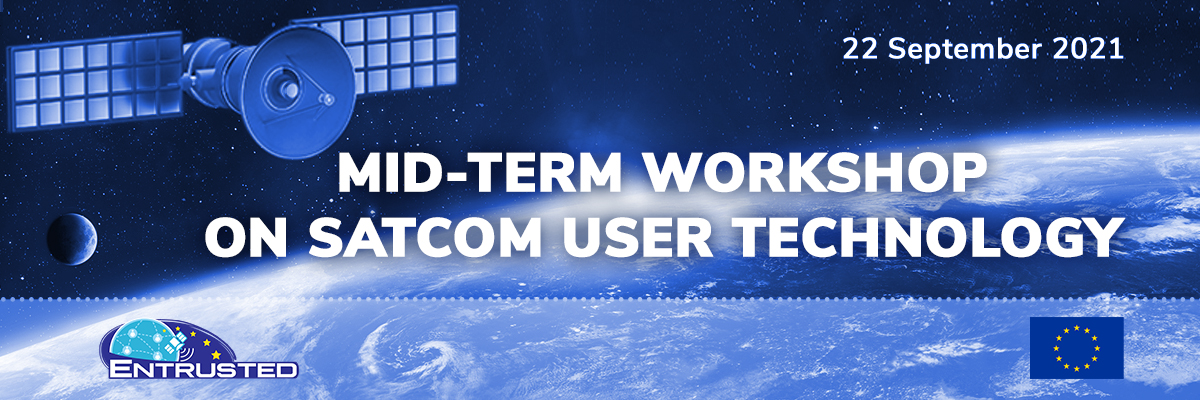Date: December 10, 2021
Category: Events
Autor: Roger Bachtin
The ENTRUSTED Consortium and external collaborators were presented with the status quo of research activities on the state-of-the-art SatCom technology and future trends during the first project workshop on 22 September 2021. This virtual event, which was prepared and moderated by Italy (Italian Space Agency) with the participation of Greece (Ministry of Digital Governance), gathered almost 50 participants representing EU Member States and EU entities.
The aim of the workshop was to present the status quo of project activities undertaken so far within Work Package 3, which focuses on the analysis of:
- existing secure SatCom that can be considered as suitable for governmental users in Europe,
- market trends and future developments of SatCom in Europe and worldwide, and
- key technological factors that can simplify the use of SatCom.
Main research activities performed during the first year of the ENTRUSTED project were dedicated to the definition of secure SatCom services suitable for GOVSATCOM purposes. A service provision scheme for governmental and commercial services was defined, together with the definition of a service access scheme. In addition, main components of a generic telecommunication SatCom system were identified. This was complemented with the analysis of security aspects that may impact SatCom systems. Research activities were concluded on a preliminary list of current SatCom systems available in Europe and that can be used in the GOVSATCOM programme.
In addition, various security threats of a SatCom system and security techniques were outlined, including Radio Frequency (RF) threats, cyber threats and generic threats, such as physical and kinetic ones. Security techniques which were mentioned comprise adaptive steering and beamforming, frequency hopping and interference localisation.
Participants were informed how insights obtained from the user consultation process implemented in Work Package 2 User Needs, Requirements and Use Cases Definition would be integrated into the research conducted in Work Package 3. Almost half of the questions included in the survey, which was addressed to governmental users of secure SatCom, are relevant to the analysis of technological aspects. These questions referred to user equipment, technology on board a satellite, ground segment, interoperability, integration with terrestrial networks or other systems, service provision, data exchanged, or the level of security to be assured.
In the second part of the workshop, a brief overview of future technology in the SatCom domain was presented. It was argued that the space industry has entered into a new era where there is demand for connectivity at anytime, anywhere and for anything, along with assured communication security and resilience. Different organisations are interested nowadays in hybrid solutions in connectivity services, combining the ground, air and space infrastructure. They need more specific solutions with no downtime in service.
New developments and challenges in the field of space-based connectivity in Europe and worldwide were also mentioned, including the satellite space race, 6G networks, satellite connectivity in smartphones, disruptive technologies or optical communications (e.g., ESA’s HydRON – Fibre in the Sky). Participants learnt about the established communication link between the land station at Chelmos (Greece) and AlphaSat using the new technology of optical radiation from a laser. In addition, they were acquainted with assumptions regarding the next generation of a secure communication system architecture with ground-based links and satellite-based RF and optical links.
The last presentation explained how the research on SatCom user technology conducted in Work Package 3 will contribute to the development of the Research and Innovation (R&I) Roadmap in Work Package 4 R&I Roadmap Definition. Deliverables elaborated in Work Package 3 will provide the description of technology that is available to users and the technology that should be made available in the near future. In addition, Work Package 3 will list capability gaps in a number of domains that need to be addressed with R&I activities (e.g., service provision and service access, space/ground/ terminal technology, security and interoperability).
The upcoming stages of research in Work Package 3 were also delineated during the workshop - they include the mapping of preliminary outputs from the state of the art technology review and future trends, as well as the capability analysis. This will be followed by the identification of thematic actions on key technological factors with gap filling capabilities – including research, development and innovation activities with their respective time frames. The research will also determine key stakeholders who could be engaged and perform such activities at a national and/or European level.
During the workshops, two Q&A sessions took place, during which participants were invited to inquire about further details of presented topics or conducted analysis, share their knowledge and provide suggestions for future work. The issues brought up during the sessions included hybrid threats to SatCom systems, the possibility of incorporating the experience gained with TESTA to the ENTRUSTED project and consultations with technology and research stakeholders regarding the current state of the art technology and future trends.
This project event provided an excellent opportunity for a broader interaction and a platform for exchanging information on secure SatCom technology in Europe between all the gathered Consortium members and external collaborators.

